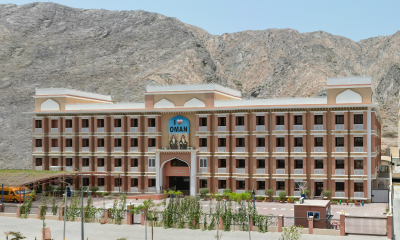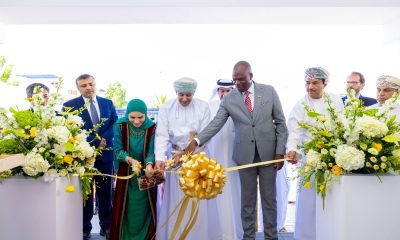News
Impact of low oil prices on construction sector

On the face of it, Oman’s construction industry has been adept at negotiating a weak oil price. But it is going through a steep learning curve where there is no dearth of new challenges such as payment delays and shortage of workers. A. Harikumar examines if the sector is getting equipped to convert such imponderables into new opportunities for growth in the long run
When oil prices fell from around $110 per barrel in June, 2014 to almost half by the end of the year, a few sections of Oman’s construction industry had raised apprehensions about its impact on the country’s economy, leading to delays and cuts in major infrastructure projects in the future, if the prices failed to rebound.
But despite the fact that crude prices are not showing any signs of recovery even after the first half of 2015, the construction sector in the Sultanate is still on a sound footing. Key infrastructure projectsare not witnessing any major cuts or delays, thanks to the government’s resolve to keep on funding them. There has not been any major lay-off of workers in the sector; and interestingly enough, new opportunities are also arising mainly in the tourism sector which is developing fast in Oman. The continued capacity building in this vital sector has brought about more opportunities for contracting companies, balancing losses, if any, from other sectors. Many new tourism projects are coming up in government and private sectors, as the government is encouraging development of tourism sector to diversify the economy.
However, this does not mean that the sector is fully equipped to handle crises and exploit emerging opportunities.Although the sector which employs over 700,000 people (accounting for more than 18 percent of Oman’s population) has been able to fend off the ill effects of falling oil prices to a great extent, the pace of growth could not be maintained in the near future because of some other reasons, which some major contracting firm attribute to the inherent weakness in the system.
For instance, Galfar Contracting, the biggest Omani contracting company, recently faced one such challenge; i.e. variations in project and differences of opinion between the client and the contractor on the charges for it. There are also complaints about inordinate delays in getting actual orders to start work, even after companies win bids. Most importantly, contracting companies in Oman find it very difficult to get the required workforce and find that Omanisation targets are unachievable.
It will be ominous for Oman’s economy, if its construction industry which had recorded an average growth rate of 5.5 per cent in the past five years and contributed to the national economy RO1.654bn -around five per cent of the GDP by 2013-gets bogged down because of such issues.
On the positive side, the government of Oman is giving much importance to the development of construction sector, as evident from the fact that the Sultanate’s latest five-year plan has earmarked an annual allocation of RO2.5bn for the sector, of which 50 per cent goes for infrastructure development. Independent agencies like MEED, which track projects in the region, put the value of new contracts that are being placed in Oman in 2015 at $15bn which will ensure continuity of growth.
However, there are many issues when it comes to the implementation stage. Many in the industry feel that if the authorities fail to remove hurdles in the execution stages, the industry will not be able to realise the full potential of the government’s initiatives.
While reviewing the situation in the construction sector in Oman and suggesting solutions, industry leaders feel that if oil prices fail to rebound by the end of this year, it will adversely affect the budgets for major projects. Many have started preparing for such an eventuality.
Impact of falling oil prices
Commenting on the present state of affairs, Oman Society of Contractors (OSC) CEO, Shahswar Al Balushi says, “The impact of oil price fall on the construction sector in Oman has been minimal till now. There has not been any drastic change in major ongoing projects, including those in the infrastructure and the tourism sectors; and there is steady progress at present. This is as a result of the prudent fiscal management of the government which has ensured growth. Crucial projects like Duqum SEZ, Oman National Railway Project, development of major airports in Oman etc which are vital for the diversification of the economy are on schedule. To sum up, at present, there is no concern about ongoing projects and no major projects have been cancelled.”
He adds, “Oman government has the experience in handling such situations. We have an aggressive approach on development in certain areas; but not so aggressive that it could go out of control.” But it is unlikely that the present situation will continue to be so for the contracting industry even if oil prices remain flat in the next year.
Looking at the future prospects, Shahswar comments, “If oil prices continue at the current level in the next year, I foresee a prioritisation of projects. If the attempts at diversifying the economy to non-oil sectors like tourism, where lots of construction is required, hit the target, there will be a level of balance. But having said that, the major player in tourism in Oman is Omran, which is a government sector company, and so there is again the possibility for prioritisation in that area of business also. Hence, we need to encourage private investment in tourism. If the price drops below the present level, then I would see more efforts from the government to stabilise the economy and make it sustainable that could mean heavy cuts in expenditure and in projects. The logic of the government action will be to create a balance in the economy so as to continue the progress. There might also arise a need to borrow money to implement important projects. Therefore, it will be prudent for the government to facilitate private investment. This can be achieved through reducing redtapism and simplifying approvals and procedures,” he avers.
OPPORTUNITIES AND CHALLENGES
However, some of the major consultants feel that certain areas in the sector have already started feeling the impact of oil price fall.
Ayman Saidi, director of infrastructure division, KEO Oman says that although some segments have been affected, Oman’s emphasis on developing tourism is leading to the implementation of more tourism-related projects. “Our initiative to diversify clients is a response to the fall in oil prices. Oil price fall impacts annual budget of the government, which in turn impacts all ministries, municipalities etc. We have noticed that some projects have been put on hold and some have been delayed, slowed down or cancelled altogether”.
He adds, “I see the fall in oil prices as an opportunity rather than a threat for Oman. Unlike other countries in the region, Oman is not completely dependent on oil and its diverse topography extending from Salalah to Musandam offers great potential for the development of tourism projects. There is a shortage of high-quality hotels in the country, especially during the peak seasons. There are only a few hotels on the beachside; therefore, more hotel projects need to be developed in that area.” He adds that the number of projects in tourism sector in Oman including three, four and five star facilities has gone up in recent years.”
According to Lorenzo Nicolai, regional manager, Renardet, one of the top multi-disciplinary consultants in the infrastructure sector in Oman, the falling oil price is affecting the sector in the sense that it now takes a longer time for projects to be awarded. “However, new projects are being announced,” he adds. “It is not known if lack of funds or other factors are leading to the slowing down in awarding projects. Either way, this is definitely affecting us.”
BMI Research in its latest report released to the media has revised growth forecast for Oman’s construction industry in 2015 from 5.5 per cent to 4.5 per cent in the light of falling oil prices and its impact on Oman’s economy. According to them, the weaker crude prices will have a moderate impact on infrastructure investment in Oman. They also said they would further revise the forecast if crude oil price continue to remain low over a sustained period of time.
However, Alpen Capital, in its report on GCC construction industry released to the media recently, expects the construction sector in Oman to remain robust. It has noted significant activities in the infrastructure and tourism sectors and in private and public commercial building construction. The report feels that the rising population and fast growing middle class will drive construction activities in the housing sector. It also notes that the diversification plans of the government will help the growth of construction sector.
GROWTH PROSPECTS IN TOURISM SECTOR
On the impact of oil price fall on projects in the tourism sector, Eng Ali bin Nasser al Rasbi, acting CEO of Omran, a government sector company which owns major projects and is currently implementing an ambitious expansion plan says, “In terms of Omran’s tourism developments and investments, no projects have been put on hold. Investing in hospitality and mixed-use developments today makes good business sense. Investments lay solid foundations for a stronger travel and tourism sector, and thus, an increasingly diversified and resilient economy in the coming years. Building capacity and capability of the sector is vital in order to accommodate a growing number of visitors arriving on our shores every year and ensuring that they will keep returning in the years to come”.
According to him, the contribution made by the travel and tourism sector to the national economy has been growing year-on-year, with a 23.8 per cent growth in visitor numbers over the last five years. This translates into increased inbound revenues for the economy, new job opportunities and greater levels of participation by the SMEs to support the sector. He adds, “At Omran, we are working hard to build capability and capacity within the sector in order to harness the Sultanate’s great potential as an international destination of choice. Investment in this sector is vital for a sustainable future for the nation.”
As a worldwide phenomenon, when oil prices drop, the currencies of non-oil producing countries appreciate as do disposable incomes, leading to an increase in international travel. If Oman can continue to position itself as an attractive destination for international travellers, it will be able to capitalise on the surge of global tourism during these times. This way, revenue changes caused by fluctuating oil prices can be somewhat offset by increased tourism activity. This highlights the vital role that travel and tourism plays in supporting a sustainable and diversified economy of the future.
Payment delays and variation in projects
Aside from oil price fall, there are some long-lasting challenges confronting the sector such as payment delays and shortage of workers. Shahswar Al Balushi has been more upfront about these issues, “Many contracting companies are not paid on time. However that is not an issue related to oil price. Funds for ongoing projects have already been allocated and current issues on the payment front are related to the clients’ willingness to pay on time and in accordance with the terms of the agreement. There are also issues related to clients’ requests for variations in the project and their readiness to account for the variations in the budget. I think one of the issues that government needs to look into is restricting the clients (in many cases government agencies) from making substantial amount of variations in projects which result in a heavy bill, not accounted for in the budgetary framework.”
-

 Banking & Finance2 weeks ago
Banking & Finance2 weeks agoOman Oil Marketing Company Concludes Its Annual Health, Safety, Environment, and Quality Week, Reaffirming People and Safety as a Top Priority
-

 Economy2 months ago
Economy2 months agoMaal Card: What Oman’s New National Payment Card Means for Everyday Users
-

 News2 months ago
News2 months agoSheikh Suhail Bahwan, Chairman of Suhail Bahwan Group, Passes Away
-

 News1 month ago
News1 month agoOIG Appoints New CEO to Lead Its Next Chapter of Excellence
-

 Economy2 months ago
Economy2 months agoOman Unveils Official Omani Rial Symbol in Landmark Move to Boost Global Currency Presence
-

 News1 month ago
News1 month agoReport: How India & The Middle East Are Exploiting Immense Economic Synergies
-

 Uncategorized1 month ago
Uncategorized1 month agoOman’s ISWK Cambridge Learners Achieve ‘Top in the World’ and National Honours in June 2025 Cambridge Series
-

 Trade1 month ago
Trade1 month agoConsulate Office of the Republic of South Africa opens in Muscat, enhancing bilateral relations




























You must be logged in to post a comment Login